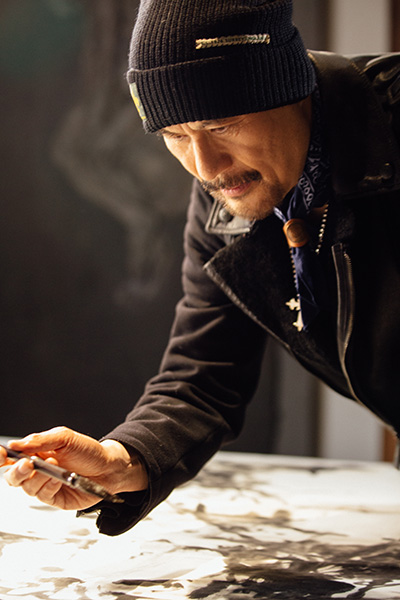You are using an out of date browser. It may not display this or other websites correctly.
You should upgrade or use an alternative browser.
You should upgrade or use an alternative browser.
Chinese tradition, ceremony,culture
- Thread starter Hendrik_2000
- Start date
Hendrik_2000
Lieutenant General
A beautiful Peranakan home and decor turn into heritage hotel. See they still practice praying to the ancestor before meal
Look like the family still manage the hotel
Look like the family still manage the hotel
Hendrik_2000
Lieutenant General
Beautiful land of my forefather
Hendrik_2000
Lieutenant General
Hendrik_2000
Lieutenant General
Celebrating The Jade Emperor's Birthday. Continuing the Peranakan Hokkien tradition. 年初九,拜天公
Hendrik_2000
Lieutenant General
Phuket’s Thai-Chinese Peranakan community, also popularly known as Phuket Babas, is predominantly of Hokkien ancestry and has long held on to its unique culture and traditions, remaining a stronghold in the Phuket community. The heart of Peranakan Phuket is located in the delightful Old Town quarter. Highly involved in the development of the tin mining industry on the island, Phuket’s Peranakan community evolved to be one of the wealthiest in Southeast Asia.
Another Nyonya princess

Hendrik_2000
Lieutenant General
New generation digs old values
Via Tashang China need to preserve the old craft and artisan as to remind the young people who they are and the value of perfection. patient and excellence
By Wang Kaihao (China Daily) 09:58, April 03, 2019
Yang Luoshu, a 19th-generation member of an artisan family, makes New Year woodblock paintings in Shandong province.[Photo provided to China Daily]
An online documentary series, now in its fourth season, shows that young people have the time and patience for tradition, Wang Kaihao reports.
Today's Chinese youth are often labeled as a generation who want everything at the click of a button. But an online documentary may change your mind and show you that they can also be patient if they want to.
When The Great Shokunin was first aired through Chinese streaming platform Youku in 2016, probably even its producers did not expect it to do so well. The show's fourth season is now available online since April 2.
In each season, the lives of dozens of artisans, who are from all over China and some neighboring Asian countries, are recorded in detail to reflect traditional Eastern aesthetics. Shokunin is a Japanese word describing an artisan who is devoted to his or her career.
Though the word is borrowed from Japan and Japanese artisans are often famed for their outstanding craftsmanship, the producers want to show that the trait is identical here in China.
"Our primary mission is to promote traditional aesthetics and touch young people's hearts," says Li Wuwang, CEO of Cicada Modern, the studio that made the documentary.
Young viewers in its previous seasons have found many idols to admire - from a centenarian tailor making cheongsam dresses in Shanghai and a 19th-generation artisan of a family line making New Year woodblock paintings in Shandong province to a lacquerware maker in Anhui province who has spent decades only to make a perfect bowl to satisfy himself.
"Intentionally or not, we're recording something that is dying, to leave something for the future," says Li.
The cheongsam maker, for example, died at 99, soon after the show was released.
"We felt sad," says Li. "But that is what time means for everyone."
And luckily, the work process of the man, who once tailored clothes for film stars in the 1930s, is recorded in the documentary. Similarly, the work of a silk artisan from Cambodia - who devoted himself to reviving a dying tradition after war ended in his country - was also recorded. The Cambodian artist died last year from cancer.
Li says preserving dying traditions is also part of Cicada Modern's mission. So, each artisan shown is interviewed for a long time. And though only a very small part of the interview is used in the documentary, Li says the rest is part of a huge database on craftsmanship.
Chu Hongsheng, a late centenarian tailor, made cheongsam his entire life.[Photo provided to China Daily]
A dynamic trial
The first three seasons are all rated around 8 out of a total 10 points on Douban, China's major entertainment review website.
And among the fans is Guo Yiyi from Chengdu, Sichuan province, who is studying traditional Chinese medicine.
Speaking about the program, she says: "Young people may have a modern lifestyle, but a pride for our nation's tradition is always in our blood. And sometimes, we just need to be inspired by something like this."
Meanwhile, despite the success of the show the production team has aimed to make some changes in the new season. They want craftsmanship to be not only celebrated, but be redefined.
So, consequently, in the fourth season, two artisans from the same genre are put together in one episode: one sticking to the traditional methodology and the other doing experiments to showcase the tradition in a modern context.
Xiong Yi, a producer of the show, explains how "young elements" blend in.
"Different facets of the same craftsmanship are displayed," she says.
"Traditions have to be ushered into young people's daily lives. Or else, they will finally be forgotten."
A traditional paper-cutting artist is thus seen in the same episode with a creative animator using a paper-cutting style. And a master maker of dough figurines appears with a pastry chef using the same technique to decorate fondant cakes.
Also on the program, a maker of porcelain ware, who rigidly sticks to a formula and artistic style from 800 years ago, appears with another artisan, who adds modern pop culture designs to traditional porcelain.
"By pairing artisans in the documentary, we don't want to judge whether the creativity is good or bad," says Li. "But we want to say traditional culture is also dynamic."
In the latest season, many artisans are seen being persistent in their pursuit of perfectionism as well as innovation.
For example, Zhong Guokang, a 62-year-old calligrapher in the show, lived like a hermit for 13 years, seldom leaving his house, yet exploring how to combine ancient stone carving with calligraphy.
Another artisan Chen Yingjie, a 28-year-old man blends Chinese ink-and-water paintings and graffiti.
Chen Yingjie blends Chinese ink-and-water paintings and the modern art of graffiti.[Photo provided to China Daily]
Feeding serious interest
As for how the show may have an impact on viewers, Li says: "Watching the show, people may be encouraged to take up handicraft as a hobby.
"We cannot say how far their hobbies will go in the future, but, at least, we've planted the seeds."
According to an analysis of viewer profiles by the production team, those most interested in the show are new graduates, meaning those who have been out of college for between three and five years.
"They still face many uncertainties in life and have great expectations of the future," says Li. "So it's easier for them to broaden their horizons and find a new direction in life."
However, youth may not be a necessity to change your life path, as a special guest on the show proves.
Hong Kong actor Elvis Tsui, 58, who was popular in the 1990s, used to be an art student in college. He also followed the late painting guru Guan Shanyue.
But Tsui gave up acting after suffering from depression. Now, for the past three years he has been painting in a gallery in Anhui province.
"I'm ashamed to be called shokunin because I have not stuck to one thing for a lifetime like others in the show," says Tsui.
"However, it needs courage to start a second life from scratch. So let's just see how far I can go."
Commenting on Tsui, Li says: "The master artisans may be around us. But it's never too late to start."

Hong Kong actor Elvis Tsui finds bliss in art off screen.[Photo provided to China Daily]
Finding ways to sustain
Li says he expects the show to run for many seasons. But faith alone cannot support such a long project, which has a relatively slow pace and subtle emotions.
Li Bing, the chief supervisor of documentaries at Youku, says The Great Shokunin still needs a development model in the long run.
"It's not necessary that something beautiful in a niche market cannot be widely accepted as well. But continuous exploration is needed to see how viewers can express support for the artisans' feelings through the products."
In the first season, for example, the documentary was linked with an online shopping platform and enabled viewers to immediately order interesting craft items made by the artisans.
However, this was stopped in the second season, because on the one hand, you had items made with time and energy but were too expensive for the young audience, and on the other hand, the artisans often could not meet the demand for products even if viewers could afford them.
But Li Bing now has another idea - he plans to ask the artisans from The Great Shokunin to design products using elements from traditional culture.
For instance, he says the show recently reached an agreement with the National Museum of China to use its huge collection of cultural relics as an inspiration to develop more products.
"We have to face the public, not a few consumers," he says. "For young people, traditional craftsmanship is not an old and remote relative. It can be their close friend."
Via Tashang China need to preserve the old craft and artisan as to remind the young people who they are and the value of perfection. patient and excellence
By Wang Kaihao (China Daily) 09:58, April 03, 2019
Yang Luoshu, a 19th-generation member of an artisan family, makes New Year woodblock paintings in Shandong province.[Photo provided to China Daily]
An online documentary series, now in its fourth season, shows that young people have the time and patience for tradition, Wang Kaihao reports.
Today's Chinese youth are often labeled as a generation who want everything at the click of a button. But an online documentary may change your mind and show you that they can also be patient if they want to.
When The Great Shokunin was first aired through Chinese streaming platform Youku in 2016, probably even its producers did not expect it to do so well. The show's fourth season is now available online since April 2.
In each season, the lives of dozens of artisans, who are from all over China and some neighboring Asian countries, are recorded in detail to reflect traditional Eastern aesthetics. Shokunin is a Japanese word describing an artisan who is devoted to his or her career.
Though the word is borrowed from Japan and Japanese artisans are often famed for their outstanding craftsmanship, the producers want to show that the trait is identical here in China.
"Our primary mission is to promote traditional aesthetics and touch young people's hearts," says Li Wuwang, CEO of Cicada Modern, the studio that made the documentary.
Young viewers in its previous seasons have found many idols to admire - from a centenarian tailor making cheongsam dresses in Shanghai and a 19th-generation artisan of a family line making New Year woodblock paintings in Shandong province to a lacquerware maker in Anhui province who has spent decades only to make a perfect bowl to satisfy himself.
"Intentionally or not, we're recording something that is dying, to leave something for the future," says Li.
The cheongsam maker, for example, died at 99, soon after the show was released.
"We felt sad," says Li. "But that is what time means for everyone."
And luckily, the work process of the man, who once tailored clothes for film stars in the 1930s, is recorded in the documentary. Similarly, the work of a silk artisan from Cambodia - who devoted himself to reviving a dying tradition after war ended in his country - was also recorded. The Cambodian artist died last year from cancer.
Li says preserving dying traditions is also part of Cicada Modern's mission. So, each artisan shown is interviewed for a long time. And though only a very small part of the interview is used in the documentary, Li says the rest is part of a huge database on craftsmanship.
Chu Hongsheng, a late centenarian tailor, made cheongsam his entire life.[Photo provided to China Daily]
A dynamic trial
The first three seasons are all rated around 8 out of a total 10 points on Douban, China's major entertainment review website.
And among the fans is Guo Yiyi from Chengdu, Sichuan province, who is studying traditional Chinese medicine.
Speaking about the program, she says: "Young people may have a modern lifestyle, but a pride for our nation's tradition is always in our blood. And sometimes, we just need to be inspired by something like this."
Meanwhile, despite the success of the show the production team has aimed to make some changes in the new season. They want craftsmanship to be not only celebrated, but be redefined.
So, consequently, in the fourth season, two artisans from the same genre are put together in one episode: one sticking to the traditional methodology and the other doing experiments to showcase the tradition in a modern context.
Xiong Yi, a producer of the show, explains how "young elements" blend in.
"Different facets of the same craftsmanship are displayed," she says.
"Traditions have to be ushered into young people's daily lives. Or else, they will finally be forgotten."
A traditional paper-cutting artist is thus seen in the same episode with a creative animator using a paper-cutting style. And a master maker of dough figurines appears with a pastry chef using the same technique to decorate fondant cakes.
Also on the program, a maker of porcelain ware, who rigidly sticks to a formula and artistic style from 800 years ago, appears with another artisan, who adds modern pop culture designs to traditional porcelain.
"By pairing artisans in the documentary, we don't want to judge whether the creativity is good or bad," says Li. "But we want to say traditional culture is also dynamic."
In the latest season, many artisans are seen being persistent in their pursuit of perfectionism as well as innovation.
For example, Zhong Guokang, a 62-year-old calligrapher in the show, lived like a hermit for 13 years, seldom leaving his house, yet exploring how to combine ancient stone carving with calligraphy.
Another artisan Chen Yingjie, a 28-year-old man blends Chinese ink-and-water paintings and graffiti.
Chen Yingjie blends Chinese ink-and-water paintings and the modern art of graffiti.[Photo provided to China Daily]
Feeding serious interest
As for how the show may have an impact on viewers, Li says: "Watching the show, people may be encouraged to take up handicraft as a hobby.
"We cannot say how far their hobbies will go in the future, but, at least, we've planted the seeds."
According to an analysis of viewer profiles by the production team, those most interested in the show are new graduates, meaning those who have been out of college for between three and five years.
"They still face many uncertainties in life and have great expectations of the future," says Li. "So it's easier for them to broaden their horizons and find a new direction in life."
However, youth may not be a necessity to change your life path, as a special guest on the show proves.
Hong Kong actor Elvis Tsui, 58, who was popular in the 1990s, used to be an art student in college. He also followed the late painting guru Guan Shanyue.
But Tsui gave up acting after suffering from depression. Now, for the past three years he has been painting in a gallery in Anhui province.
"I'm ashamed to be called shokunin because I have not stuck to one thing for a lifetime like others in the show," says Tsui.
"However, it needs courage to start a second life from scratch. So let's just see how far I can go."
Commenting on Tsui, Li says: "The master artisans may be around us. But it's never too late to start."

Hong Kong actor Elvis Tsui finds bliss in art off screen.[Photo provided to China Daily]
Finding ways to sustain
Li says he expects the show to run for many seasons. But faith alone cannot support such a long project, which has a relatively slow pace and subtle emotions.
Li Bing, the chief supervisor of documentaries at Youku, says The Great Shokunin still needs a development model in the long run.
"It's not necessary that something beautiful in a niche market cannot be widely accepted as well. But continuous exploration is needed to see how viewers can express support for the artisans' feelings through the products."
In the first season, for example, the documentary was linked with an online shopping platform and enabled viewers to immediately order interesting craft items made by the artisans.
However, this was stopped in the second season, because on the one hand, you had items made with time and energy but were too expensive for the young audience, and on the other hand, the artisans often could not meet the demand for products even if viewers could afford them.
But Li Bing now has another idea - he plans to ask the artisans from The Great Shokunin to design products using elements from traditional culture.
For instance, he says the show recently reached an agreement with the National Museum of China to use its huge collection of cultural relics as an inspiration to develop more products.
"We have to face the public, not a few consumers," he says. "For young people, traditional craftsmanship is not an old and remote relative. It can be their close friend."
kwaigonegin
Colonel
Can we discuss the 'dragon' topic here? 






